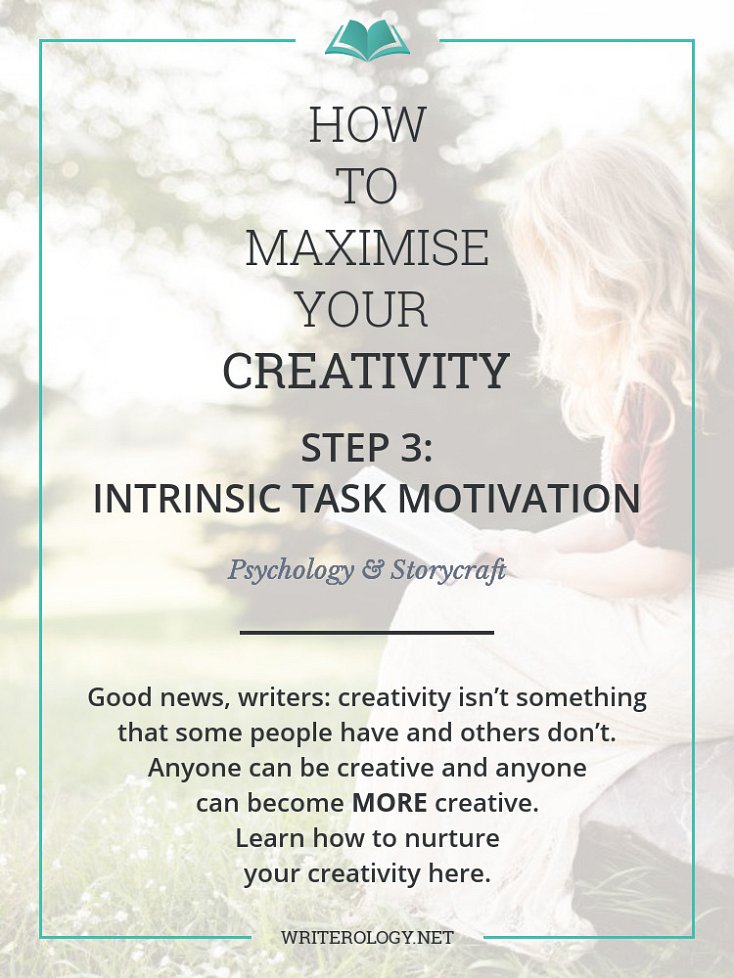How to Maximise Your Creativity | Step 3: Intrinsic Task Motivation
Nurturing your creativity and motivation to write is an important part of being a writer. How can you do that? Using the Componential Theory of Creativity. Now for the third component.
Feeding your creative side and maintaining motivation to write is crucial to being a writer, particularly if you want to write regularly. But how exactly can you do that? Teresa Amabile suggests using the Componential Theory of Creativity.
What’s that again? Let me explain.
According to the Componential Theory of Creativity, everyone with normal abilities can produce creative works, and that our social environment, such as where we live and work, can influence just how creative we are and how often we channel that imagination.
The theory itself is made up of three parts, all necessary for creativity:
EXPERTISE + CREATIVE THINKING + INTRINSIC TASK MOTIVATION
So now that you’ve refreshed your memory as to what the Componential Theory is, time to put it into practice.

“The unspoken factor is love. The reason I can work so hard at my writing is that it’s not work for me.”
— John Irving
How motivated you are to complete a task divides what you can do from what you will do. You can be the greatest writing expert in the world, with a vast range of creative thinking skills, but if you aren’t motivated to write, those abilities will mean very little.
Being motivated to carry out a task will affect just how much you use your expertise and creative thinking skills—and it will affect how creative you are overall.
So what is task motivation?
See that quote from novelist John Irving? For him, writing is a labour of love, something he enjoys and is deeply interested in. In other words, he has an intrinsic motivation to complete the task.
Task motivation can be divided into two categories:
Intrinsic task motivation
People who are intrinsically motivated do things because they find them satisfying, are driven by curiosity, or find them a personal challenge.
Extrinsic task motivation
In contrast, people who are extrinsically motivated do things because they have a goal other than the work itself, like earning money, winning a prize or meeting a deadline.
If you apply this to the world of words, people with an intrinsic motivation write for the sake of writing, whereas people with an extrinsic motivation write to get something from others.
According to the Componential Theory of Creativity, creativity is at its maximum when your skills overlap with your intrinsic task motivation. In fact, to some extent, having high intrinsic motivation to write can make up for low expertise and creative thinking, because you’re more likely to work hard to improve those areas and draw on skills from other parts of your life.
Often people will have a mix of intrinsic and extrinsic motivations, with one being primary and the other secondary. However, if your primary motivation to write is intrinsic, because you love it, then you’re much more likely to have creative insights than if your primary motivation to write is extrinsic, because you want to be famous or earn money or meet your deadline.
Combining Motivations
All this doesn’t mean to say that an extrinsic motivation is bad, however.
I received a comment on a post that explores task motivation in more detail, One Simple Way to Cultivate Creativity and Banish Writer’s Block, raising the issue of how an extrinsic motivational orientation can be motivating as well—and research suggests it indeed can.
Obviously, an intrinsic orientation towards a subject is very important to motivation and creativity—the more you’re passionate about the subject, the more enthusiastic and imaginative you’re likely to be—but being extrinsically oriented, for example, by reward, recognition for creative ideas, and constructive feedback, can add to how motivated and creative you are.
So, if your primary motivation is intrinsic, but you also have some extrinsic motivation (e.g., you write because you love to and have a deadline that keeps you productive), then you’re likely to be even more creative.
Over to You
How can you use this information to make you more creative? Here are three challenges to remind yourself of your task motivation and use it to maximise your creativity:
Think about your reasons for writing
Make a list of all the reasons you have for writing, whether they’re intrinsic, extrinsic, good or bad or just plain silly. Be honest with yourself and dig deep. Why do you write? What motivates you to come back to your stories each time? Once you have a list, circle the most important ones. Are they intrinsic or extrinsic or a mix of both?
Tweet your reasons for writing using the #whyIwrite hashtag and I’ll share mine with you!
Do the same for your current work-in-progress
What do you love most about the story you’re currently working on? Why did you start writing it in the first place? Which of the characters are your favourites and why?
Make another list of why you’re working on your current story and what you love about it, then read over that list whenever you sit down to work on it.
Put your intrinsic reasons for writing somewhere visible
Remind yourself of how much you love to write every day by making your reasons for writing visible. Print them out and place them on your desk, frame them and put them on your wall, write them on sticky notes and pin them around the house.
Not only does this remind you of why you write and reconnect you with your core values, it also acts as a prompt for your writing sessions. It’s harder to forget to write or tell yourself that you can’t be bothered when there are all these good reasons for writing staring at you wherever you go.